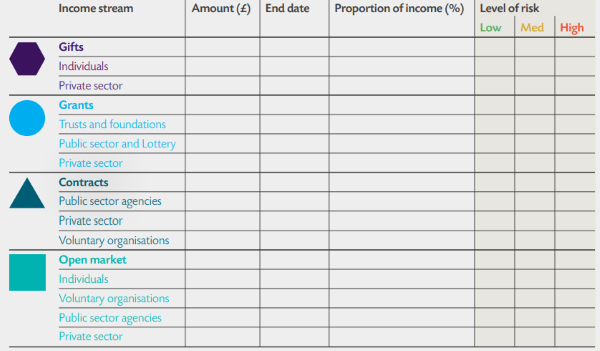In this second part of his series on resilience, Robin Aitken takes a look at what to do when the going gets tough and the income streams dry up.

You are the head of finance for a smallish charity that provides mental health services. You are on your way home. It’s not been a good day. The adrenaline is still churning around your body from today’s unwelcome news. You know that there is a good chance that you will not sleep well tonight.
You have just heard that the local government grant which funds your largest project has been cut; not reduced – cut completely. Bang goes 60% of your income.
What are you going to do?
This position of losing a significant chunk of income will, sadly, be familiar to many. With government still pulling in its belt and the impact of the latest financial crisis, a lot of charity funding has either reduced or dried up completely. But we know that. That’s why we are here – to help those in need when times are tough.
In this situation, you are first going to need to:
- Look at your reserves: what have you got tucked away that can help you weather this storm?
- Re-forecast: what does your cashflow look like without this income?
- Cut costs and sadly, in all likelihood, cut services as well. With such a large drop in income this is probably inevitable. But if you want your charity to survive you need to face up to the savings that need to be made and act as quickly as you can. You will try to replace the income that has been lost but it is going to be tough to find enough money quickly enough to avoid some cutbacks.
Your thoughts then drift onto the important lessons: How could this situation have been avoided and how can you prevent it from happening again in future?
Lesson 1: don’t beat yourself up
You tried your best with the right intention. You probably knew that this concentration of income from one source was risky. Be kind to yourself and give yourself a break. You didn’t intend this to happen. You were just busy with other stuff. The best thing you can do is to work with your team to learn the lessons and try to put things right.
Lesson 2: review the level of risk in your revenue streams
As in nature, resilience lies in diversity: in this case in diversity of sources of income. If you come to rely too much on one donor or income stream there is always going to be a chance that it dries up with the ensuing problems that this will cause.
Any revenue stream or funder that makes up more than 25% of your total income is going to present significant risks if they disappear.
NCVO’s tool for reviewing the risk in your income stream has been around for a while: The Income Spectrum tool (see figure 1 below).
Instructions for how to complete it are shown in the link. I recommend that you complete the tool and review its output with help from trustees, colleagues and, potentially, key donors. These conversations and the checklist should give you a good idea of where you stand now and begin to indicate how you can build resilience in going forward.

Figure 1: NCVO Income Spectrum tool (2014)
Lesson 3: build a strategic approach to fundraising
Research by the CIoF has shown, unsurprisingly, that organisations that plan their income growth and invest in the revenue-generating skills and activities tend to be much more successful in raising funds that those who leave it to chance.
What does a ‘strategic approach’ mean? Here are some thoughts:
- Do the analysis shown in lesson 2.
- Include your board, management team and other colleagues in the planning process.
- Identify what makes your charity different to others, as well as its strengths and its weaknesses.
- Talk to your beneficiaries and people who are experts in your area of activity, internally and beyond, to understand what they think of what you do, what opportunities exist, as well as areas where it seems that others might be better at doing certain things.
- Consider what partnerships it is worth building to complement your services.
- Have a clear explanation of how your organisation delivers its impact and benefits those it is helping. This can be encapsulated in a clear Theory of Change.
- Create a plan that shows how you think that you can build revenue, including consolidation of existing sources, building some of your smaller ones and finding some new ones.
- Ask your board to review and sign off the agreed plan. You want backing and understanding from the top.
- Invest in the resources required to build more diversified revenue. These could be from an in-house fundraiser or external consultants or volunteers. Whatever, you are going to need people who can spend time in having the conversations and doing the work that will lead to more diverse income.
- Measure your progress both for internal monitoring and to show donors and other funders how you are holding yourselves accountable. These measures should cover not only the outputs of your services, their costs and your revenues, but also indicators that show how you are getting on in building the activities that will deliver future income e.g. number of meetings made with potential donors; scoring of levels of interest; number of grant applications made.
Lesson 4: build relationships – this will take time
Any funding is going to come from people: people who trust you, believe in your cause and have the means to give you money: either theirs or someone they represent.
They may require more than this, for example a clear demonstration of how you are going to deliver against the criteria that they have for donating money.
Building trust takes time and energy. It will take months and years to build the sort of relationship with potential funders before they give. But every journey starts with a single step.
You need to send those initial emails, pick up the phone and meet with people who can give you money. By asking people for help, they can share their thinking and, hopefully, their contacts to help you move towards your goal: more funding from more diverse sources.
Lesson 5: don’t be afraid to ask for core and resilience funding
Funding for central or 'core' costs that are not directly related to the projects or services that your organisation delivers can often be a headache. Many project funders are not willing to fund these centrally shared core costs or, at the very least, will challenge the amounts involved.
Although it is reasonable for funders to ask you to be accountable for the costs that you incur, it is in, my opinion, unreasonable if they will simply not fund your central costs: how do they think you find and manage the people who deliver your services if you can’t fund an HR function, or pay your bills without a finance team?
One way to avoid this, is to try to take the question off the table. Actively go and look for funding that will pay for your central core costs.
The other difficult ask is for money to rebuild reserves. The difficulties of the Covid lockdown and the cost-of-living crisis have hit many charities’ reserves. Now is probably the time to start building these again, so that you are ready for the next upheaval.
If you can find someone who is willing to act as a sustainable source for core funding or to help you build reserves, then you have struck gold, especially if they are prepared to do this on an ongoing basis.
“Impossible!” you say. “Difficult!” I reply. It can be hard, but gold is worth searching for. It can be found.
Lesson 6: try things and learn
As you are trying new things, not everything is going to work. Not every conversation will lead to money. But you can learn something from every step that you take. Part of the resilience-building exercise is learning from the disappointments and the setbacks, as well as the successes.
Celebrate the successes when they happen, however small. Just taking the time to punch the air and congratulate one of your team when someone says they will meet them, can give them the energy that they need to keep going.
As you may have gathered, this process of growing income diversity and resilience is not easy. It’s going to take time. But you know that. You did not join the charity world for 'easy'. You joined it to help others when times are hard. Keep at it. Look after yourselves. And learn from nature – diversity leads to strength and the resilience to fight another day.